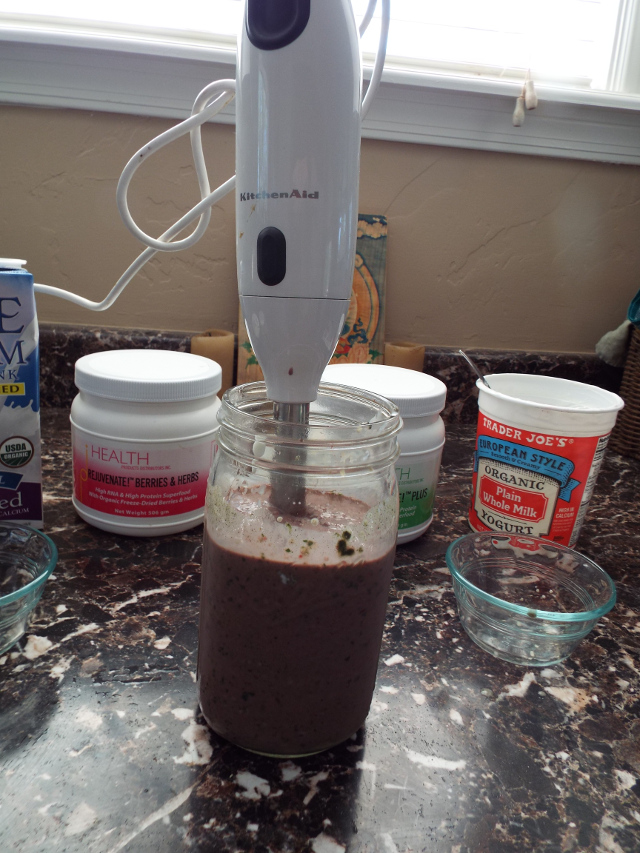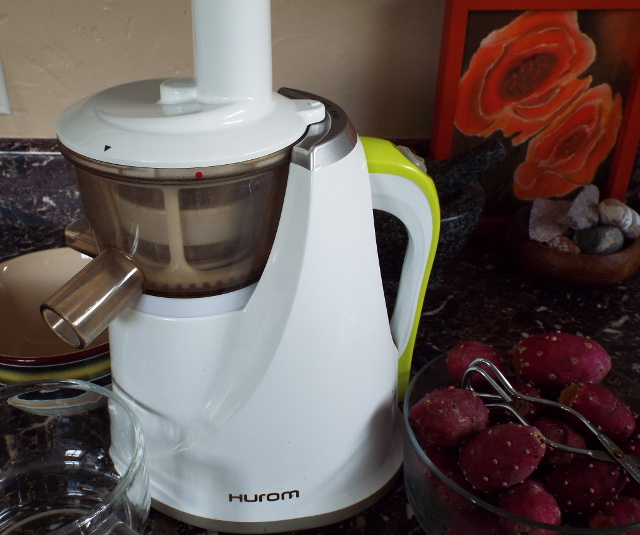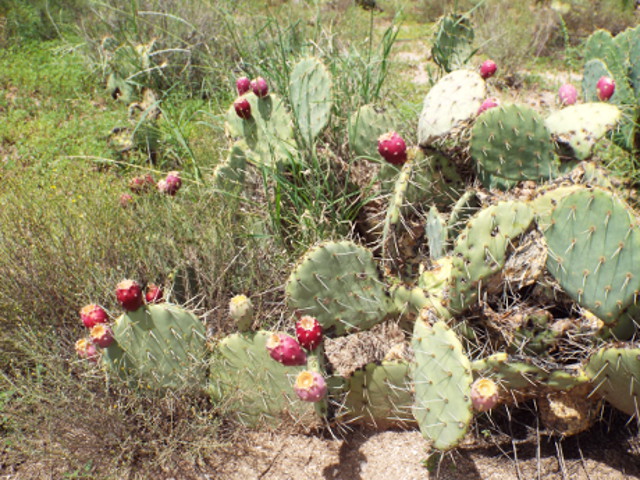Summer is in full swing and so are many native plants that flourish with the Sonoran desert monsoon rains. Our yard is full of wild amaranth and purslane, two amazingly nutritious “weeds.”
With the desert in full bloom, it is relatively easy to consume local foods in season just by heading out the back door.
I’ve been making a smoothie every morning with a large handful of wild amaranth leaves. The purslane is so tasty that I’ve been grazing on it directly from the yard. But is is also delicious in smoothies, salads, and stir-fries, or put into foods like quesadillas or sandwiches.
Here is the recipe for my Amaranth Rejuvenate! Power Smoothie. I also include other recipe ideas for juicing amaranth, purslane, and prickly pear fruits.
AMARANTH REJUVENATE!™ POWER SMOOTHIE
INGREDIENTS
• 1 frozen or fresh Fig*
• Several chunks frozen Mango*
• Frozen or fresh Blueberries*
• 1 Cup plain organic Yogurt (Greek-style works nicely)
• 1–2 Scoops REJUVENATE! PLUS / Berries & Herbs / Original Greens
• 1 Teaspoon raw organic Cacao powder (optional)
• Organic rice/almond/hemp milk add to create to desired consistency
• 1–2 Handfuls wild Amaranth leaves, Purslane or other fresh greens like spinach, kale, etc.
• Sprig of fresh Mint (optional)
(*any frozen organic fruit can be substituted)
DIRECTIONS
Place in a large mason jar and blend with hand blender. Or use a regular blender. Serve and enjoy!!
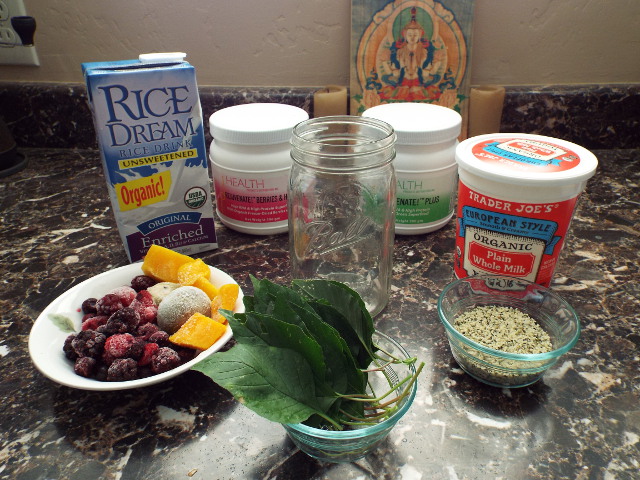
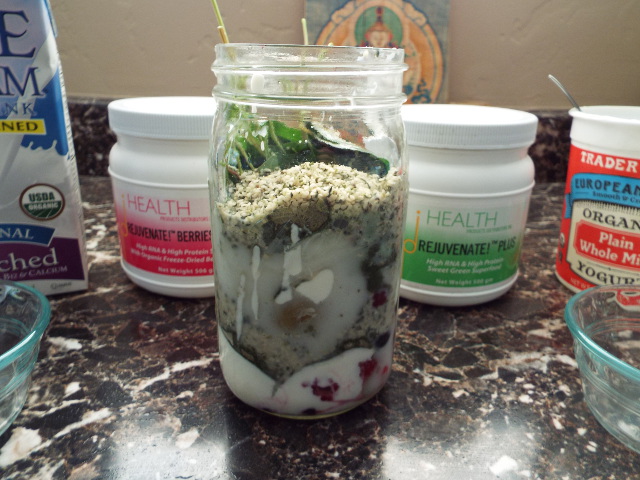
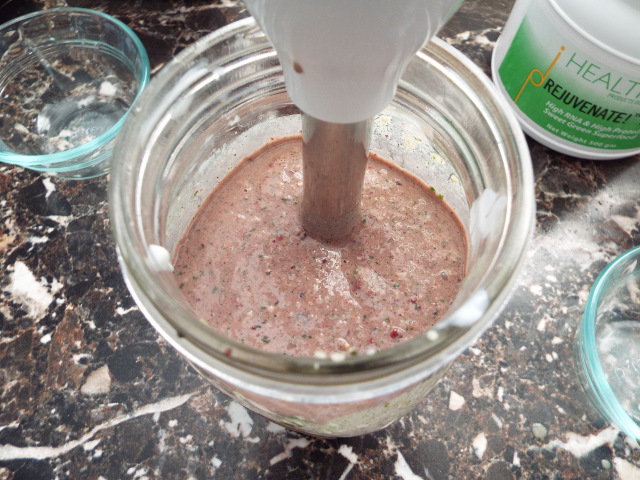
AMARANTH IS A NUTRITION POWERHOUSE
You may never have eaten amaranth, but chances are good it grows near you. There are more than 60 species of amaranth. Not only does it grow in temperate and tropical regions around the world, but also is cultivated widely as a leaf vegetable and for its seeds. The leaves, stems, and roots are consumed in East, Souththeast, and South Asia (including China and India), the Mediterranean, Africa, and the Americas.
The word amaranth derives from Greek “amarantos” meaning “unfading.” The Greek word in turn derives from an ancient Indian Sanskrit word meaning “immortal immortal.” That’s an illustrious etymological significance for a plant our culture often regards as a weed.
Amaranth historically holds importance as a staple food among Native American cultures. Known to the Aztecs as “huauhtli,” it constituted perhaps 80% of caloric consumption before the arrival of the Spanish in Mesoamerica.
Native American cultures consumed amaranth greens, but primarily used the seeds as a grain. Amaranth seed is considered a pseudograin (like quinoa) due to its flavor and cooking properties. It is gluten free, high in protein, and easy to prepare.
The Aztecs used amaranth extensively in their religious ceremonies, especially those dedicated to their sun god Huitzilopochtli. During ritual ceremonies, the Aztecs would create a statue of him made of amaranth grain. Pieces of this statue were distributed among the celebrants.
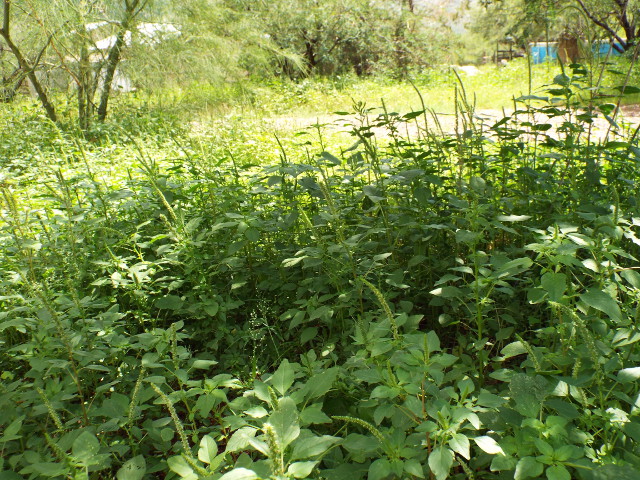
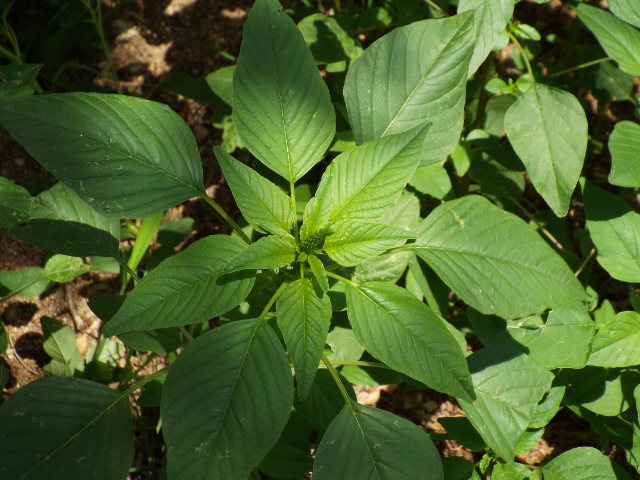
The Spanish outlawed cultivation of amaranth (and chia seeds) thereby removing an important part of the Aztec diet. Notably, amaranth seed is high in lysine, an amino acid which is low in corn (another Aztec staple food) and therefore helped balance their diet.
Aztecs didn’t drink smoothies or juice greens. Yet, amaranth is back in cultivation in the Americas, and grows wild in yards (like ours) everywhere. Take a closer look at the weeds in your yard. You might just find breakfast, dinner, or a nutritious smoothie ingredient!!
PURSLANE
Purslane is a succulent that is tender, juicy, and slightly tangy or tart. There is plenty of it growing in our yard. In fact, it grows just about anywhere from meadows, forests and deserts to urban lots and sidewalk cracks. Consider yourself fortunate if this wild edible grows in your yard or neighborhood because its nutritional content is second to none.

Purslane is a rich source of antioxidants, essential fatty acids, dietary fiber, as well as vitamins and minerals. It provides more nutrients than almost any of the greens we typically consume today. Vitamins it contains include vitamin A, B1, B2, B3, B6, C, and E. Purslane also offers calcium, magnesium, iron, copper, manganese, phosphorous, and especially potassium.
Purslane not only provides a wide range of nutrients, but offers them in abundance. It is particularly high in vitamin E and contains six times more beta-carotene than spinach. The levels of essential fatty acids it provides are the highest among all leafy green vegetables.
Purslane makes an excellent addition to your smoothies and juices. It is also superb in salads, soups, or steamed.
PRICKLY PEAR FRUITS
Another desert monsoon delectable is the prickly pear fruit. Our family went out this weekend and harvested the ripest fruits and juiced them. The juice is sweet enough to drink by itself or even watered down a bit. (Note: use tongs to pull fruits from cactus paddles to avoid sharp spines and tiny glochids on the fruit surfaces.)
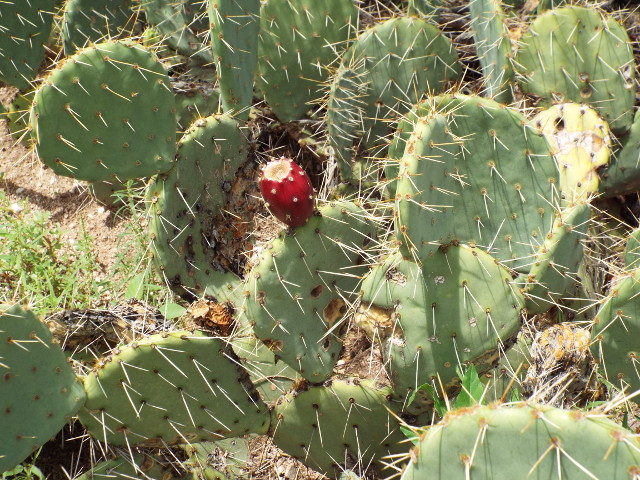
I juiced the prickly pear fruit and amaranth plant separately, and then mixed them together. Drinking that juice is a real power boost!
The Hurom juicer (single augur) does much better with prickly pear fruit than the twin gear Green Star, which became quickly jammed with seeds.
Some people might like to add pineapple juice or lemon juice and maple syrup to concentrated amaranth juice. Note that for juicing purposes, the entire amaranth plant can be juiced (leaves, stalks and all).
Add a scoop of Rejuvenate! (original) superfood plus a dash of lemon juice and maple syrup to the amaranth and prickly pear juice for a real lift to your day!
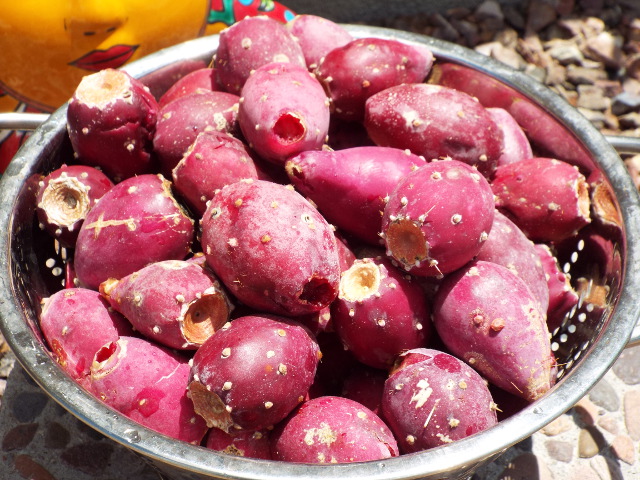
PRICKLY PEAR REJUVENATE DRINK
INGREDIENTS
• 6–10 ounces Prickly Pear fruit juice (fresh is best)
• 1 scoops REJUVENATE! (Original Greens) superfood
• 1–2 ounces Amaranth juice (or to taste) (optional)
• Organic Lemon juice or Pineapple juice (to taste) (optional)
• Maple syrup (to taste) (optional) (grade B organic best)
DIRECTIONS
Juice the prickly pear fruits and amaranth leaves (separately or together). Mix together with Rejuvenate! original (or the Rejuvenate! superfood of your choice). Add lemon or pineapple juice and/or grade B organic maple syrup. Enjoy!
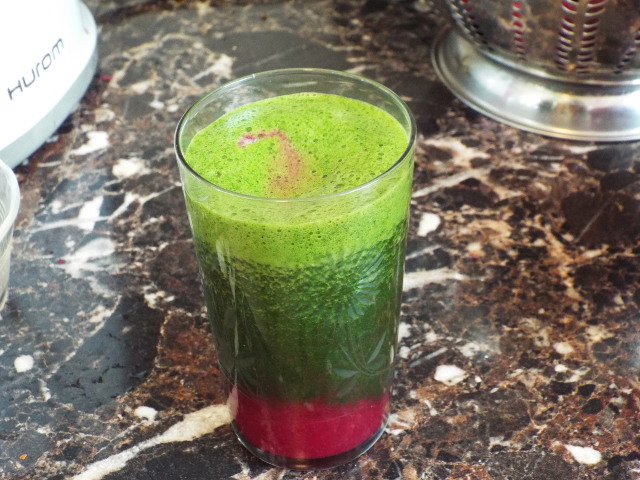
PRICKLY PEAR LEMONADE
We enjoy a delicious variant of the Prickly Pear Rejuvenate Drink we call “prickly pear lemonade.” Prickly Pear Lemonade is very refreshing and hydrating on warm summer days. It is delicious with maple syrup, chlorella, or Rejuvenate! superfoods.
INGREDIENTS
• 2 Ounces Lemon juice (fresh squeezed or bottled) (organic)
• 2–4 Ounces Prickly Pear fruit juice
• 6–8 Ounces fresh water
• Rejuvenate! Superfoods (optional)
• Maple syrup (to taste) (grade B organic) (optional)
• Chia seeds (whole or ground) (optional)
• Ice (optional)
• Mint sprigs (optional)
(Recipe makes 10–14 ounces. Adjust ingredients to taste or when making larger quantities.)
DIRECTIONS
Fill glass or pitcher with fresh water. Add prickly pear juice, lemon juice, and maple syrup. Add Rejuvenate! superfoods, chlorella, chia seeds, mint sprigs, and/or ice, as desired.
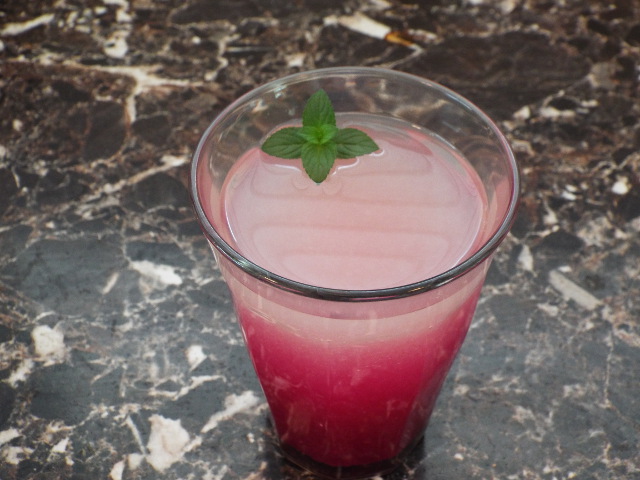
The rains of summer bring a burst of life into the desert, including a wide variety of edible plants and their fruits. We are blessed that our yard and surrounding area provide such an abundance of fresh greens and prickly pear fruits. We will consume them in our smoothies and juices well into the fall.
RESOURCES
Nature’s Garden: A Guide to Identifying, Harvesting, and Preparing Wild Edible Plants
The Forager’s Harvest: A Guide to Identifying, Harvesting, and Preparing Wild Edible Plants
Edible Wild Plants: Wild Foods From Dirt To Plate
Backyard Foraging: 65 Familiar Plants You Didn’t Know You Could Eat
Free Food and Medicine Worldwide Edible Plant Guide
Why is Wild Purslane a Prized Superfood?
REJUVENATE! SUPERFOODS
Rejuvenate! Superfoods: Which One is Right for Me?
PHOTO GALLERY
